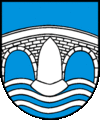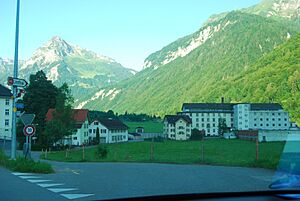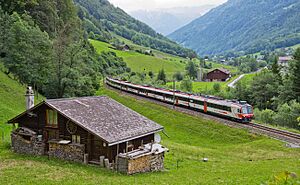Rüti, Glarus facts for kids
Quick facts for kids
Rüti
|
||
|---|---|---|
|
Village (and former municipality)
|
||
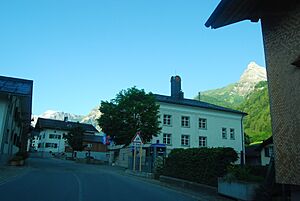 |
||
|
||
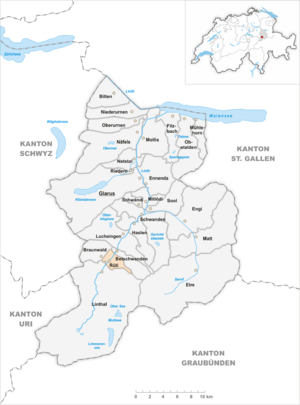
The former municipal area
|
||
| Country | Switzerland | |
| Canton | Glarus | |
| Municipality | Glarus Süd | |
| Area | ||
| • Total | 6.18 km2 (2.39 sq mi) | |
| Elevation | 620 m (2,030 ft) | |
| Population
(December 2020)
|
||
| • Total | 364 | |
| • Density | 58.90/km2 (152.5/sq mi) | |
Rüti is a small village in the beautiful country of Switzerland. It used to be its own town, but now it's part of a larger area called Glarus Süd in the canton of Glarus.
History of Rüti
Rüti was first mentioned in old records around the year 1340. For a long time, farming was the main way people made a living here.
In the 1600s, many people in Rüti started spinning cotton by hand. This was a popular way to make textiles. However, by 1770, this work became less common, and people faced harder times.
Things got better when the first big cotton mill opened in 1847. This factory used machines to spin and weave cotton. Another similar factory opened in 1850, making both wool and cotton fabrics. These factories brought many new workers to Rüti. Sadly, both factories closed down in 2002.
In 1879, Rüti became connected to the Swiss railway system. This made it easier for people and goods to travel.
The nearby village of Braunwald used to be part of Rüti until 1939. Then, it became its own separate town. But on January 1, 2011, Rüti and Braunwald, along with other towns, joined together to form the new, larger municipality of Glarus Süd.
Geography of Rüti
Rüti is located in a valley next to the Linth river. The village itself sits on the east side of the river. It's about 620 meters (2,034 feet) above sea level.
To the south of Rüti is the village of Linthal. To the north, you'll find Betschwanden. High above on the western side of the valley is the resort village of Braunwald. It's about 600 meters (1,969 feet) higher than Rüti.
The area that used to be the municipality of Rüti covers about 6.2 square kilometers (2.4 square miles). A large part of this land, about 57%, is covered by forests. About 24% is used for farming. A smaller part, around 5%, has buildings and roads. The rest of the land includes rivers, mountains, or glaciers.
Getting Around Rüti
Rüti is on Hauptstrasse 17, which is a main road that goes through the entire canton of Glarus. This road then climbs up the Klausen Pass into another canton called Uri.
There's also a railway line that runs next to the main road and the Linth river. The Klausen Pass is usually only open for cars from June to September. For the rest of the year, the road and railway are the only ways to reach the village.
Rüti has its own train station called Rüti GL railway station. You can catch the Zürich S-Bahn train service S25 here. This train runs every hour between Linthal and Zürich.
People of Rüti
Rüti has a population of about 364 people. Some of the people living in Rüti are from other countries.
Most people in Rüti speak German. This is the main language spoken by about 75% of the population. Other languages spoken include Serbo-Croatian and Italian.
In Switzerland, people generally have a good education. In Rüti, more than half of the adults (between 25 and 64 years old) have completed advanced education, like a university degree.
The unemployment rate in Rüti is quite low, around 1.86%. This means most people who want to work can find jobs.
People in Rüti work in different types of jobs:
- Primary sector: This includes jobs like farming. About 21 people work in this area.
- Secondary sector: This involves manufacturing and making things. About 14 people work in this sector.
- Tertiary sector: This covers service jobs, like working in shops or offices. About 11 people work in this area.
Here's a look at how the population of Rüti has changed over the years:
| year | population |
|---|---|
| 1692 | 256 |
| 1837 | 814 |
| 1850 | 809 |
| 1900 | 919 |
| 1950 | 821 |
| 2000 | 444 |
See also
 In Spanish: Rüti (Glaris) para niños
In Spanish: Rüti (Glaris) para niños


